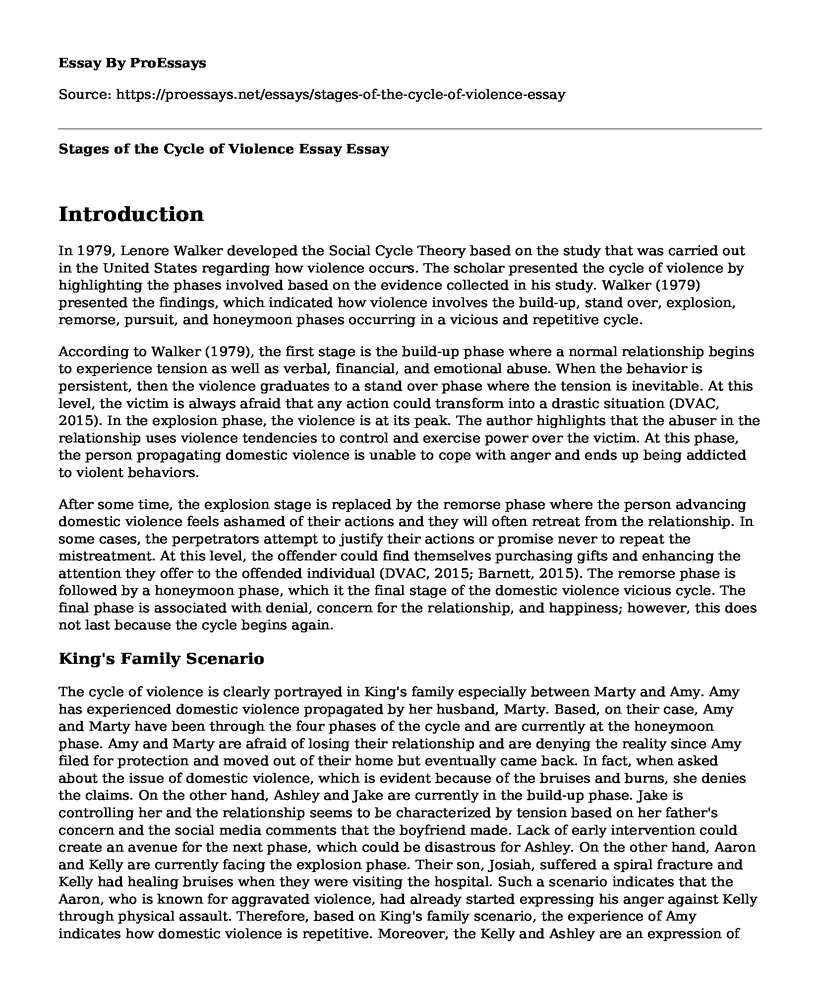Introduction
In 1979, Lenore Walker developed the Social Cycle Theory based on the study that was carried out in the United States regarding how violence occurs. The scholar presented the cycle of violence by highlighting the phases involved based on the evidence collected in his study. Walker (1979) presented the findings, which indicated how violence involves the build-up, stand over, explosion, remorse, pursuit, and honeymoon phases occurring in a vicious and repetitive cycle.
According to Walker (1979), the first stage is the build-up phase where a normal relationship begins to experience tension as well as verbal, financial, and emotional abuse. When the behavior is persistent, then the violence graduates to a stand over phase where the tension is inevitable. At this level, the victim is always afraid that any action could transform into a drastic situation (DVAC, 2015). In the explosion phase, the violence is at its peak. The author highlights that the abuser in the relationship uses violence tendencies to control and exercise power over the victim. At this phase, the person propagating domestic violence is unable to cope with anger and ends up being addicted to violent behaviors.
After some time, the explosion stage is replaced by the remorse phase where the person advancing domestic violence feels ashamed of their actions and they will often retreat from the relationship. In some cases, the perpetrators attempt to justify their actions or promise never to repeat the mistreatment. At this level, the offender could find themselves purchasing gifts and enhancing the attention they offer to the offended individual (DVAC, 2015; Barnett, 2015). The remorse phase is followed by a honeymoon phase, which it the final stage of the domestic violence vicious cycle. The final phase is associated with denial, concern for the relationship, and happiness; however, this does not last because the cycle begins again.
King's Family Scenario
The cycle of violence is clearly portrayed in King's family especially between Marty and Amy. Amy has experienced domestic violence propagated by her husband, Marty. Based, on their case, Amy and Marty have been through the four phases of the cycle and are currently at the honeymoon phase. Amy and Marty are afraid of losing their relationship and are denying the reality since Amy filed for protection and moved out of their home but eventually came back. In fact, when asked about the issue of domestic violence, which is evident because of the bruises and burns, she denies the claims. On the other hand, Ashley and Jake are currently in the build-up phase. Jake is controlling her and the relationship seems to be characterized by tension based on her father's concern and the social media comments that the boyfriend made. Lack of early intervention could create an avenue for the next phase, which could be disastrous for Ashley. On the other hand, Aaron and Kelly are currently facing the explosion phase. Their son, Josiah, suffered a spiral fracture and Kelly had healing bruises when they were visiting the hospital. Such a scenario indicates that the Aaron, who is known for aggravated violence, had already started expressing his anger against Kelly through physical assault. Therefore, based on King's family scenario, the experience of Amy indicates how domestic violence is repetitive. Moreover, the Kelly and Ashley are an expression of how violence begins with tension and build up to physical assault.
References
Barnett, P. (2015). The Walker Cycle of Violence and Its Applicability to Wife Battering in the South African Context. University of Witwatersrand, Johannesburg.
DVAC. (2015). The Cycle of Violence. Domestic Violence Action Center. Available at: https://www.dvac.org.au/wp-content/uploads/2015/06/Cycle-of-Violence.pdf
Walker, L. (1979). The Battered Woman. Harper and Row: United States.
Cite this page
Stages of the Cycle of Violence Essay. (2022, Jun 27). Retrieved from https://proessays.net/essays/stages-of-the-cycle-of-violence-essay
If you are the original author of this essay and no longer wish to have it published on the ProEssays website, please click below to request its removal:
- Resistance Movement Strategies
- Research Paper on Substance Abuse Disorder
- Paper Example on Women's Rights: How Far Have We Really Come?
- Articles Analysis Essay on Relation Between Waters "Once Again" and Stratton "Colonial Citizens"
- Essay Example on Addiction: The Automatic Behavior of Alcohol & Drug Abuse
- Unemployment & Poverty: Sub-Sahara's Woes & Economic Fluctuations - Essay Sample
- Research Paper on Online Human Trafficking: Exploitation Enabled By Internet Platforms







